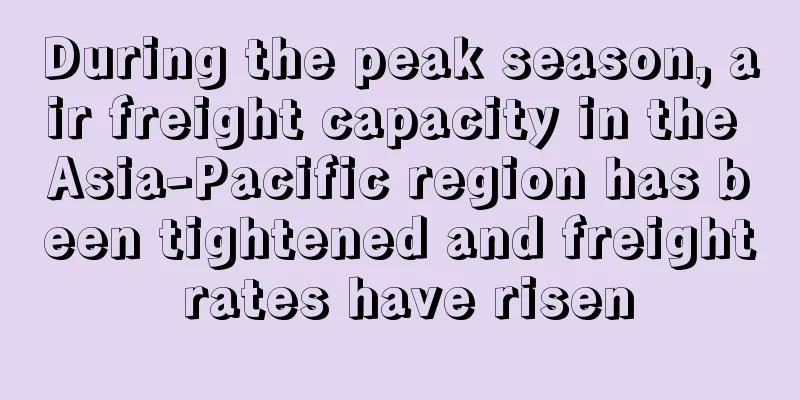During the peak season, air freight capacity in the Asia-Pacific region has been tightened and freight rates have risen

|
According to foreign media reports, due to the chaos in ocean shipping and the increase in consumer demand during the peak season, air freight capacity in the Asia-Pacific region is currently shrinking and express freight prices are rising.
According to survey data from the Association of Asia Pacific Airlines (AAPA), air cargo demand increased by 26% last month year-on-year in terms of freight tonne-kilometers. The increase in volume was mainly driven by the expansion of e-commerce and increased demand for express shipments.
Congestion at China’s seaports also boosted demand for air freight, but a lack of passenger flights from affected regions and limited belly space meant capacity grew by just 17.8% year-on-year, the Association of Asia Pacific Airlines (AAPA) said.
“Asia’s international travel market has remained stagnant, while other regions have gradually resumed recovery. At the same time, air freight demand continues to drive airline operations in the region,” said Subhas Menon, director general of the Association of Asia Pacific Airlines (AAPA).
In practical terms, in its latest Asia-Pacific market update, Maersk said the fourth quarter would surpass 2019 as “one of the strongest air cargo peaks in the industry”.
For example, Maersk noted that air cargo volumes at major Japanese airports Tokyo Narita and Osaka Kansai have been strong over the past two months “due to disruptions to ocean freight.” Kansai saw a 20.2% increase in August compared to 2020. Additionally, South Korean airports saw a 26.7% year-on-year increase in cargo volumes in August, mainly due to car exports to the United States, China and Vietnam. Freight rates to South Korea and Japan are increasing rapidly as a knock-on effect of additional air freight disruptions from China.”
Maersk said strong export demand from Indonesia and the Philippines, combined with reduced airline operations, had led to tight capacity and high freight rates to the United States and Europe.
Sunny Ho, executive director of the Hong Kong Shippers Council , said Hong Kong's freight volumes grew by about 15% in August as "disruption" in ocean freight prompted importers to turn to air freight. In addition, he stressed that "the possibility of missing out on peak sales during Thanksgiving and Christmas has led to an increase in air freight demand."
Meanwhile, Ho noted that the cost of charter flights has tripled compared to a year ago and doubled compared to four months ago. Charter prices are expected to rise further as the traditional peak season approaches - and there is essentially no spare freighter capacity available. Asia Pacific transportation Freight |
>>: Is the Indian site about to be launched? Shopee has already started recruiting investors
Recommend
What is sinco? sinco Review, Features
Sinco Food Equipment was founded in 2002 and has m...
What is Marc Jacobs? Marc Jacobs Review, Features
Marc Jacobs is an American brand founded in 1986 b...
What is BestBuy? BestBuy Review, Features
Best Buy is the world's largest retail, distri...
What is teastore? teastore Review, Features
Teastore was established in 1996 to provide Ottaw...
What is Quiet Light? Quiet Light Review, Features
Quiet Light is an e-commerce brand acquisition com...
With a half-year revenue of 3.2 billion, Zhiou dominates the Amazon TOP list! Zhiou is about to go public
Recently, Zhiou restarted its IPO, submitted list...
What is IEPost? IEPost Review, Features
IEPost is a service provider dedicated to providin...
What is Shanghai Baihui Shipping Co., Ltd.? Shanghai Baihui Shipping Co., Ltd. Review, Features
Shanghai Baihui Shipping Co., Ltd. was establishe...
What is Perfect Money? Perfect Money Review, Features
<span data-docs-delta="[[20,{"gallery"...
Amazing! Amazon sold 4.2 billion in 9 months
Recently, several cross-border e-commerce giants ...
Amazon's inventory capacity has been adjusted again, with some sellers increasing their prices by 20,000!
The peak season is approaching, which should be a...
What is More4Motion? More4Motion Review, Features
More4Motion is a website that specializes in sell...
The sustainable shopping craze continues, with searches for refurbished products on eBay increasing by 1,800% on Black Friday!
According to an analysis of sales on this year’s ...
Hundreds of merchants were fined for no reason! A well-known cross-border platform was blocked for rights protection
Recently, the well-known cross-border platform Tx...
eBay Mexico's first quarter sales data released these two categories have the fastest sales growth!
eBay Mexico sales data for the first quarter of 2...









